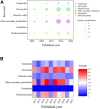Secondary Metabolites of Osmanthus fragrans: Metabolism and Medicinal Value
- PMID: 35924042
- PMCID: PMC9340074
- DOI: 10.3389/fphar.2022.922204
Secondary Metabolites of Osmanthus fragrans: Metabolism and Medicinal Value
Abstract
Osmanthus fragrans (scientific name: Osmanthus fragrans (Thunb.) Lour.) is a species of the Osmanthus genus in the family Oleaceae, and it has a long history of cultivation in China. O. fragrans is edible and is well known for conferring a natural fragrance to desserts. This flowering plant has long been cultivated for ornamental purposes. Most contemporary literature related to O. fragrans focuses on its edible value and new species discovery, but the functional use of O. fragrans is often neglected. O, fragrans has many properties that are beneficial to human health, and its roots, stems, leaves, flowers and fruits have medicinal value. These characteristics are recorded in the classics of traditional Chinese medicine. Studies on the metabolites and medicinal value of O. fragrans published in recent years were used in this study to evaluate the medicinal value of O. fragrans. Using keywords such as metabolites and Osmanthus fragrans, a systematic and nonexhaustive search of articles, papers and books related to the medicinal use of Osmanthus fragrans metabolites was conducted. Fifteen metabolites were identified through this literature search and classified into three categories according to their properties and structure: flavonoids, terpenes and phenolic acids. It was found that the pharmacological activities of these secondary metabolites mainly include antioxidant, anticancer, anti-inflammatory and antibacterial activities and that these metabolites can be used to treat many human diseases, such as cancer, skin diseases, cardiovascular diseases, and neurological diseases. Most of the reports that are currently available and concern the secondary metabolites of Osmanthus fragrans have limitations. Some reports introduce only the general classification of compounds in Osmanthus fragrans, and some reports introduce only a single compound. In contrast, the introduction section of this paper includes both the category and the functional value of each compound. While reviewing the data for this study, the authors found that the specific action sites of these compounds and their mechanisms of action in plants are relatively weak, and in the future, additional research should be conducted to investigate this topic further.
Keywords: Osmanthus fragrans; flavonoids; medicinal compound; phenolic acids; secondary metabolites; terpenoids.
Copyright © 2022 Fu, Xu, Qian, Koo, Duan, Weng, Fan, Chen and Zhu.
Conflict of interest statement
Author KH-L was employed by RCI Research Institute Limited. The remaining authors declare that the research was conducted in the absence of any commercial or financial relationships that could be construed as a potential conflict of interest.
Figures



References
-
- Bai X. (2016). Study on the Chemical Constituents of Chinese Medicine Forsythia. Heilongjiang Med. 29, 601–602. 10.14035/j.cnki.hljyy.2016.04.002 - DOI
-
- Bao Q., Dan W., Tsing L. K., Swift S., Mingming Z., Yun L. (2018). Antioxidant Activity of Osmanthus Flavonoids In Vitro and In Vivo . Food Res. Dev. 39, 14–20.
-
- Camargo L. R. P., de Carvalho V. M., Díaz I. E. C., Paciencia M. L. B., Frana S. A., Younes R. N., et al. (2020). Susceptibility of Virulent and Resistant Escherichia coli Strains to Non-polar and Polar Compounds Identified in Microplumeria Anomala. Vet. World 13, 1376–1387. 10.14202/vetworld.2020.1376-1387 - DOI - PMC - PubMed
-
- Castejón M. L., Montoya T., Alarcón-de-la-Lastra C., Sánchez-Hidalgo M. (2020). Potential Protective Role Exerted by Secoiridoids from Olea europaea L. in Cancer, Cardiovascular, Neurodegenerative, Aging-Related, and Immunoinflammatory Diseases. Antioxidants 9, 149. 10.3390/antiox9020149 - DOI - PMC - PubMed
Publication types
LinkOut - more resources
Full Text Sources

